A Blissful Idyll: The Beauty of The Stuttgart Playing Cards
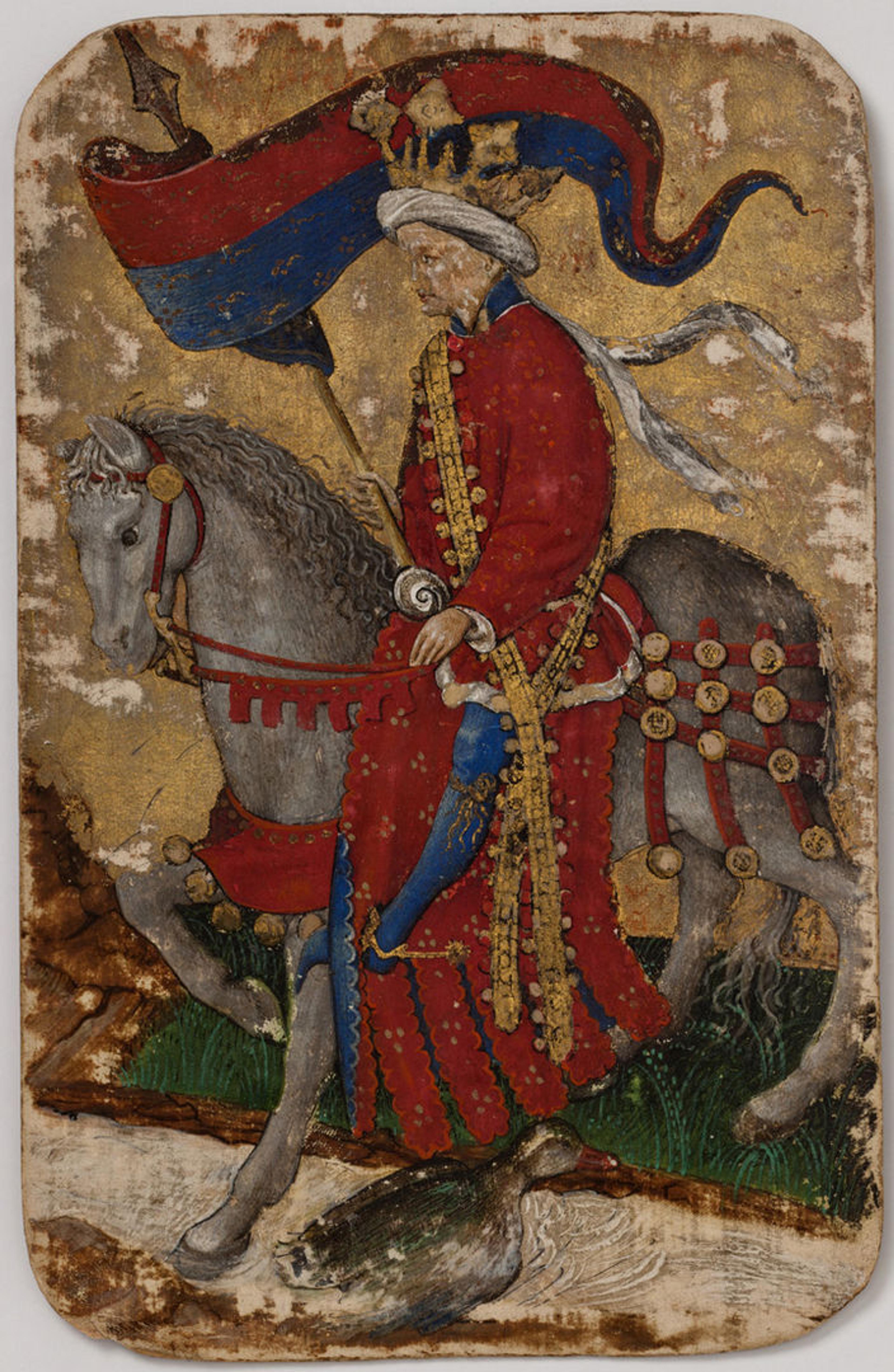
King of Ducks, from The Stuttgart Playing Cards, ca. 1430. Made in Upper Rhineland, Germany. Paper (six layers in pasteboard) with gold ground and opaque paint over pen and ink; 7 1/2 x 4 3/4 in. (19.1 x 12.1 cm). Landesmuseum Württemberg, Stuttgart
«The earliest preserved European playing cards belong to a luxury deck known as The Stuttgart Playing Cards, which date to about 1430. Exquisitely hand painted on a gold ground, each card is a workof art. The high quality of the painting and remarkably good state of preservation indicate that the pack was likely commissioned as a collector's item rather than for play. The original commissioner is unknown, but these exceptionally fine and unusually large cards soon found their way into the collections of the dukes of Bavaria. They are first mentioned in an inventory of the archducal Kunstkammer, or cabinet of curiosities, compiled in 1598.»
The suit signs of The Stuttgart Playing Cards are Falcons, Ducks, Hounds, and Stags, and each suit comprises 13 cards, for a total of 52. For Falcons and Ducks, the sequence is a mounted king, an upper knave, an under knave, a banner (10), and 9 through 1; for Hounds and Stags, an enthroned queen, an upper dame, an under dame, a banner (10), and 9 through 1. This segregating of the sexes may seem odd to us now, but a 14th-century treatise describes another deck of playing cards structured in this way.
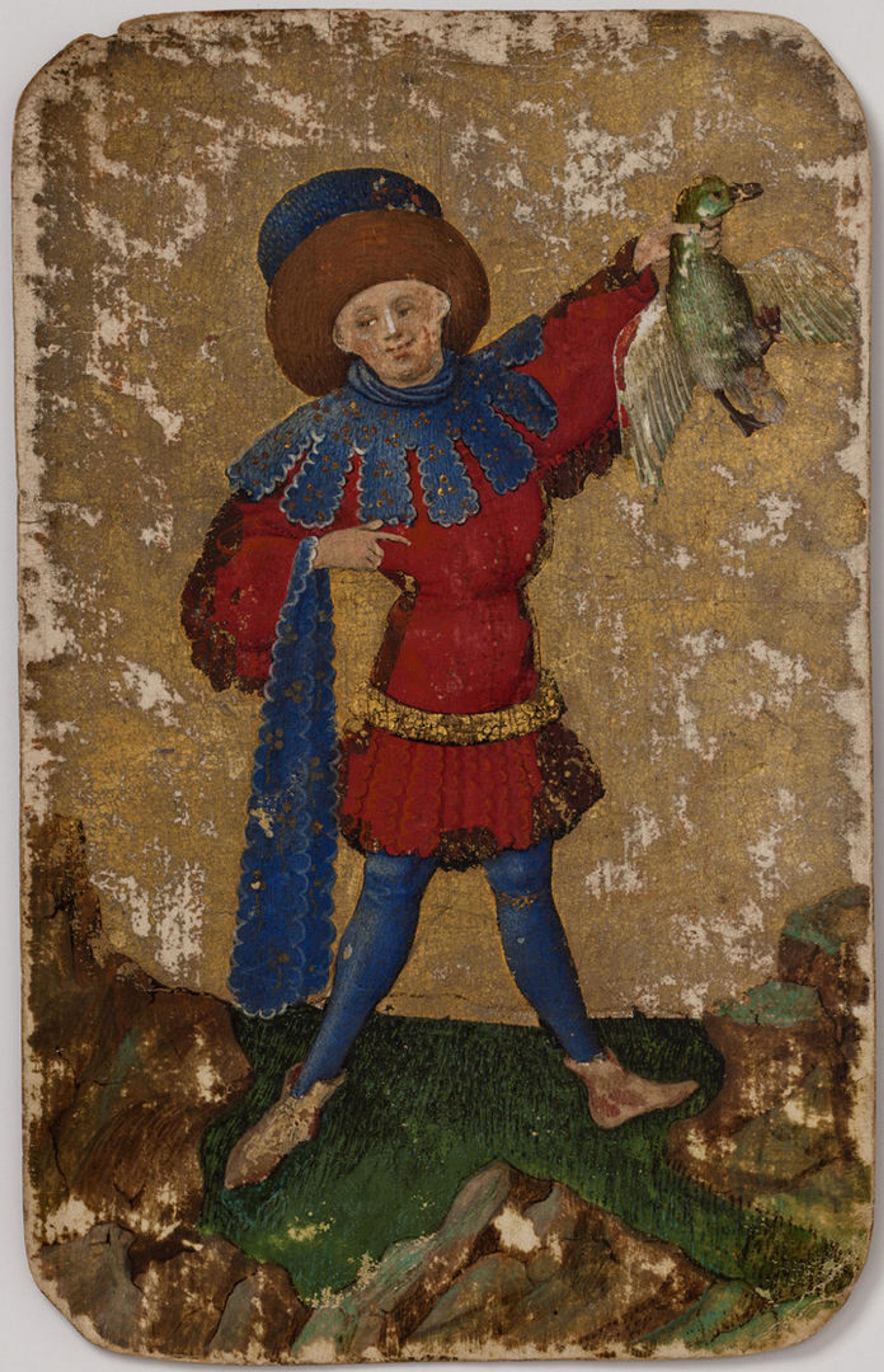
Upper Knave of Ducks, from The Stuttgart Playing Cards. Landesmuseum Württemberg, Stuttgart (KK grau 41)
The largest of all the early playing cards, these are made of six layers of paper glued together to make pasteboard. Some of the paper has watermarks that have been identified with a paper mill in Ravensburg, Germany, and can be dated to between 1427 and 1431, which, along with the style, supports the generally accepted date of about 1430. The corners of these cards are rounded, and there is some wear, particularly on the gold ground. Because the wear is on the high relief areas of the cards' uneven surfaces, it evidently resulted from the abrasion caused by stacking one card on another over the centuries. There is no wear or accumulated grime concentrated along the lower edges, where cards are typically handled—a further indication that they were intended primarily for visual appreciation.
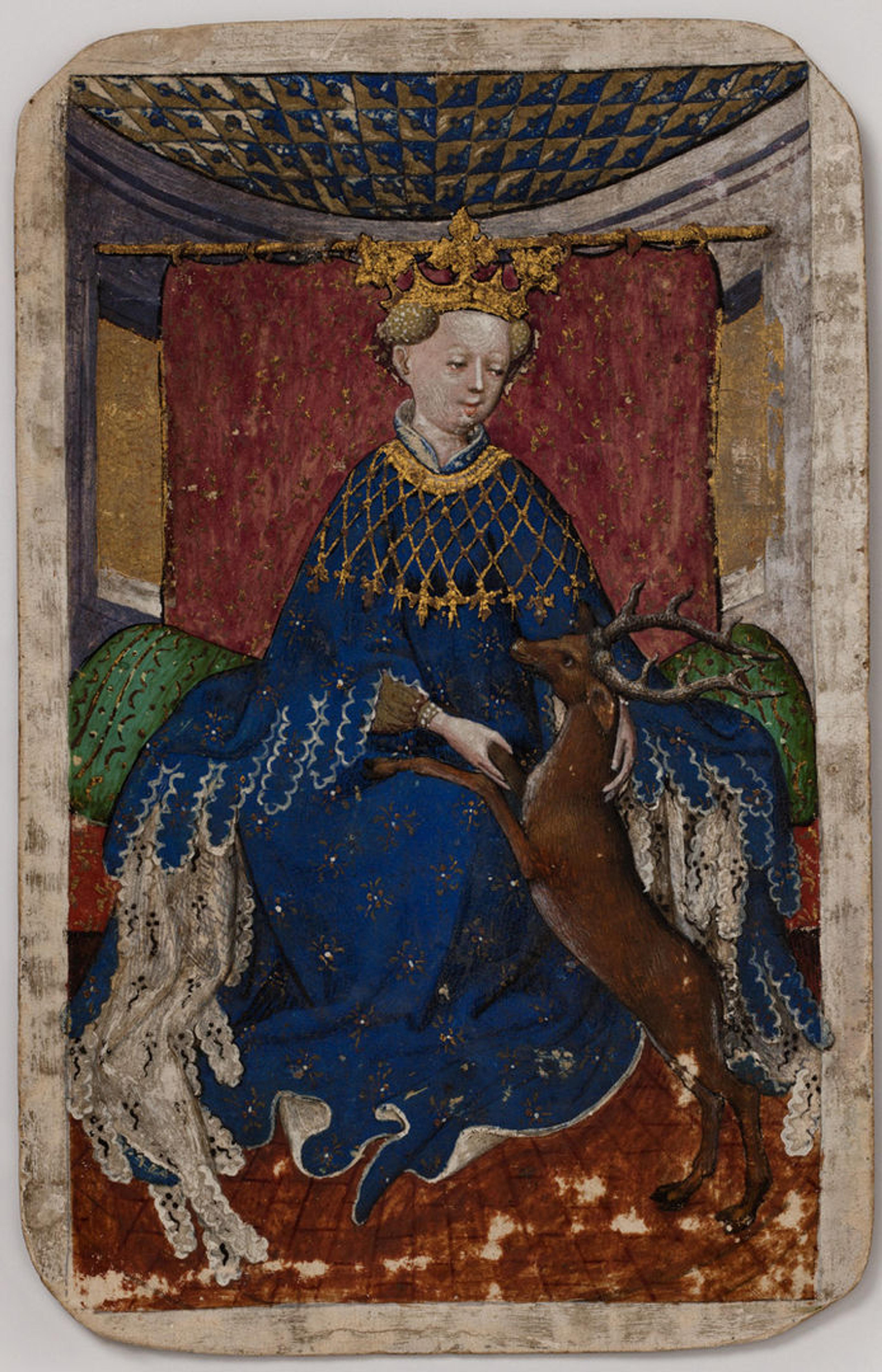
Queen of Stags, from The Stuttgart Playing Cards. Landesmuseum Württemberg, Stuttgart (KK grau 15)
The painter of these cards first coated the pasteboard with a white primer that they then smoothed and polished, a technique commonly used in panel painting. They painted the backs with red lead containing vermilion. For the background of every card, they laid down a thin red bole, over which they applied and burnished gold leaf, again as one would in panel painting.
The painter generally mixed the pigments with lead white. For some elements, like the feathers of the falcons, they applied a thin black glaze over white to yield shades of gray. They used several different techniques of applying gold and silver to achieve varying optical effects. Finally, the painter used glazes of red lake over the gold to tone the feet and bills of the ducks as well as the perches and hoods of the falcons, while using a green glaze on the heads of several ducks. After they laid down the gold ground, they etched in outlines of the suit symbols. However, painters often chose to alter the position of legs, heads, and wings.

Left: 3 of Ducks, from The Stuttgart Playing Cards. Landesmuseum Württemberg, Stuttgart. Right: The etched lines on this card show that the stags originally had raised forelegs, but the painter chose to lower them. 3 of Stags, from The Stuttgart Playing Cards. Landesmuseum Württemberg, Stuttgart
The workshop responsible for these cards also used model books, which can be seen in the 4 of Hounds. The leads of the two lower hounds are taut as though they are tugging away from their handler, but the end of the leash hangs slack.
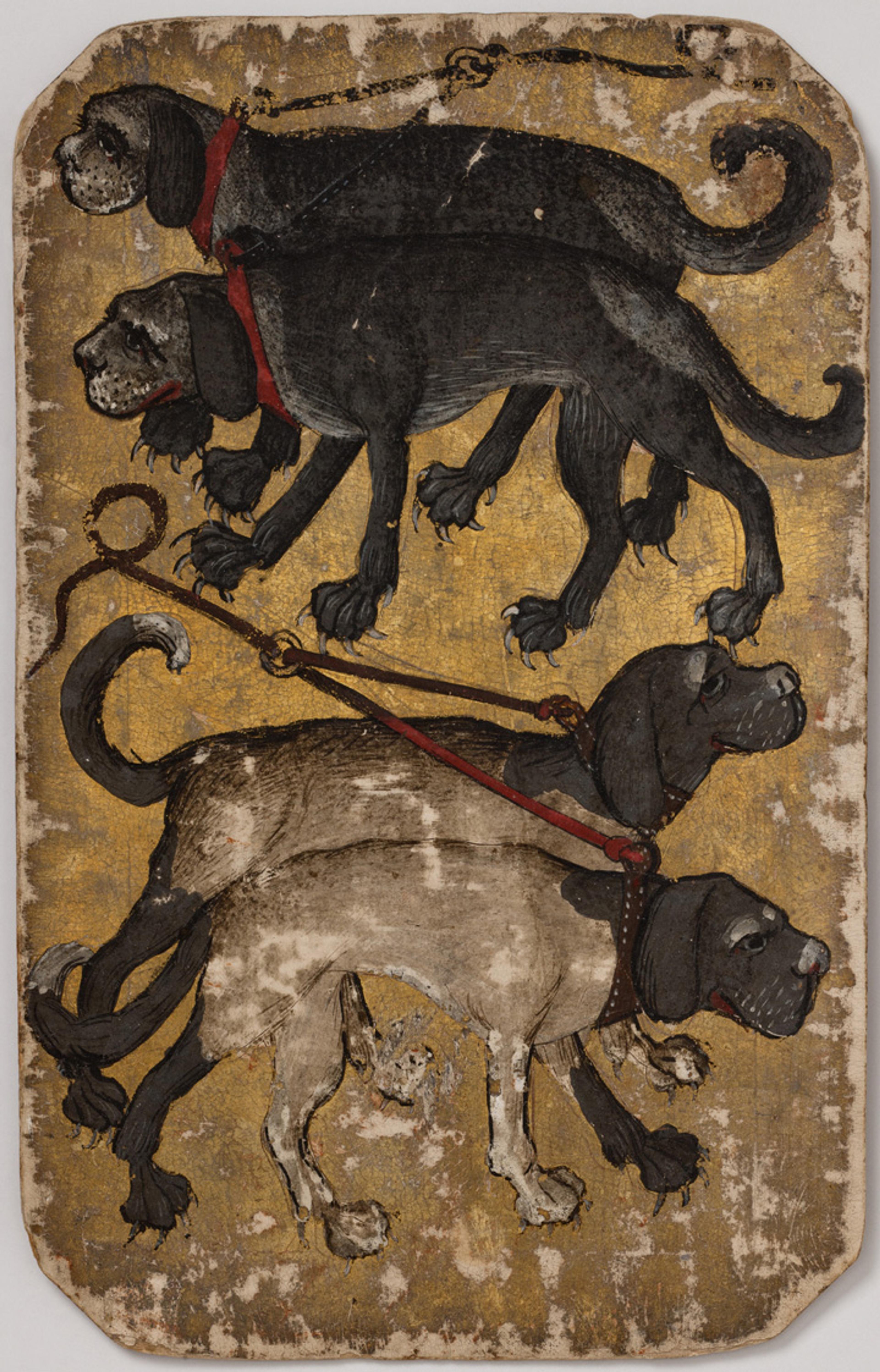
4 of Hounds, from The Stuttgart Playing Cards. Landesmuseum Württemberg, Stuttgart
There are two different types of hunts depicted in the imagery of The Stuttgart Playing Cards. While the kings and their courts control the falcons, the queens and their courts are in charge of the hounds. This seems a curious mismatch, as falconry was the one hunting sport in which ladies were allowed to participate, but as no hunt ever actually takes place, the point is moot. Falcons, which were trained to strike their prey, take on the suit of Ducks. Hounds were used to bring down large game, which, in this case, are the Stags.
The falcons are shown mostly on their perches, some tethered, some hooded, and one in flight. The raptors are frozen in varied postures, some calmly perched, others agitated, some with talons raised, others with wings partially outstretched, and several with lures in their talons or beaks. The ducks are more animated, shown grooming, drying their wings, sleeping, feeding, and scratching—all very lifelike and suggesting observation of nature.
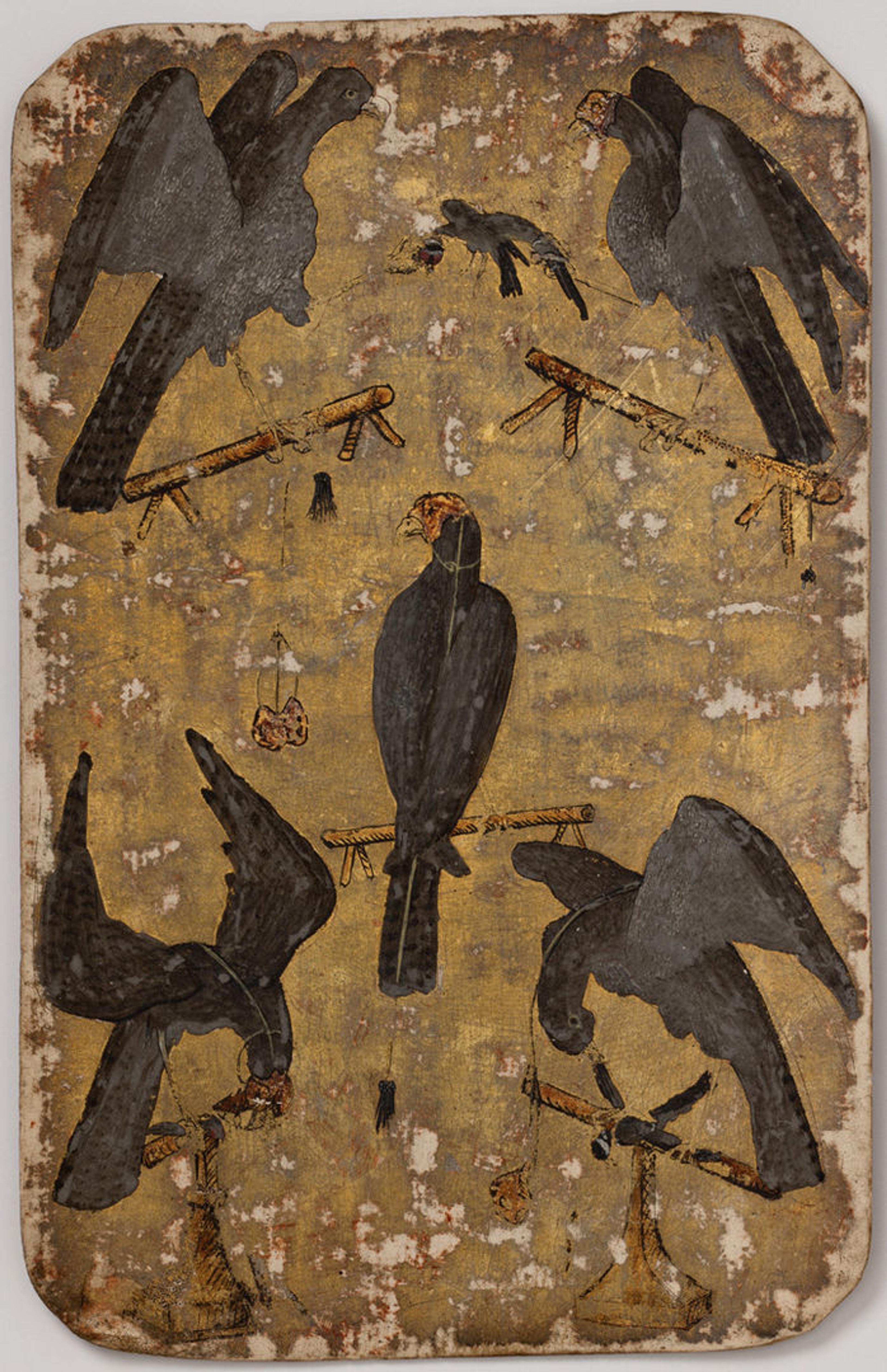
5 of Falcons, from The Stuttgart Playing Cards. Landesmuseum Württemberg, Stuttgart
The hounds are all of the mastiff type, large and powerful animals used to bring down wounded or cornered prey. Again, the animals indulge in every manner of activity: scratching, sniffing, sitting, lying, licking, and gnawing on bones. The stags are shown in varied positions, but their activities are far more limited than those of the hounds.

7 of Hounds, from The Stuttgart Playing Cards. Landesmuseum Württemberg, Stuttgart
The contrast between the pip cards and the face cards is striking. Whereas the suit symbols, whether hunter or prey, reflect a naturalism based on a familiarity with and a knowledge of the various types of hunts, the face cards have scant connection to any aspect of the hunt. The childlike figures with round, smooth faces project the insouciance of a world free from worry or strife. The violence of the hunt is eschewed.
The King of Falcons is oblivious to the falcon gripping a lure in its talons on the ground below, and the Upper Knave of Falcons, who is turned out in the high fashion of the 1420s, has a falcon docilely perched on his forearm, without hood or tether, as though a mere accessory. The Under Knave of Ducks bends his head, as though in intimate communication with the bird at his feet.
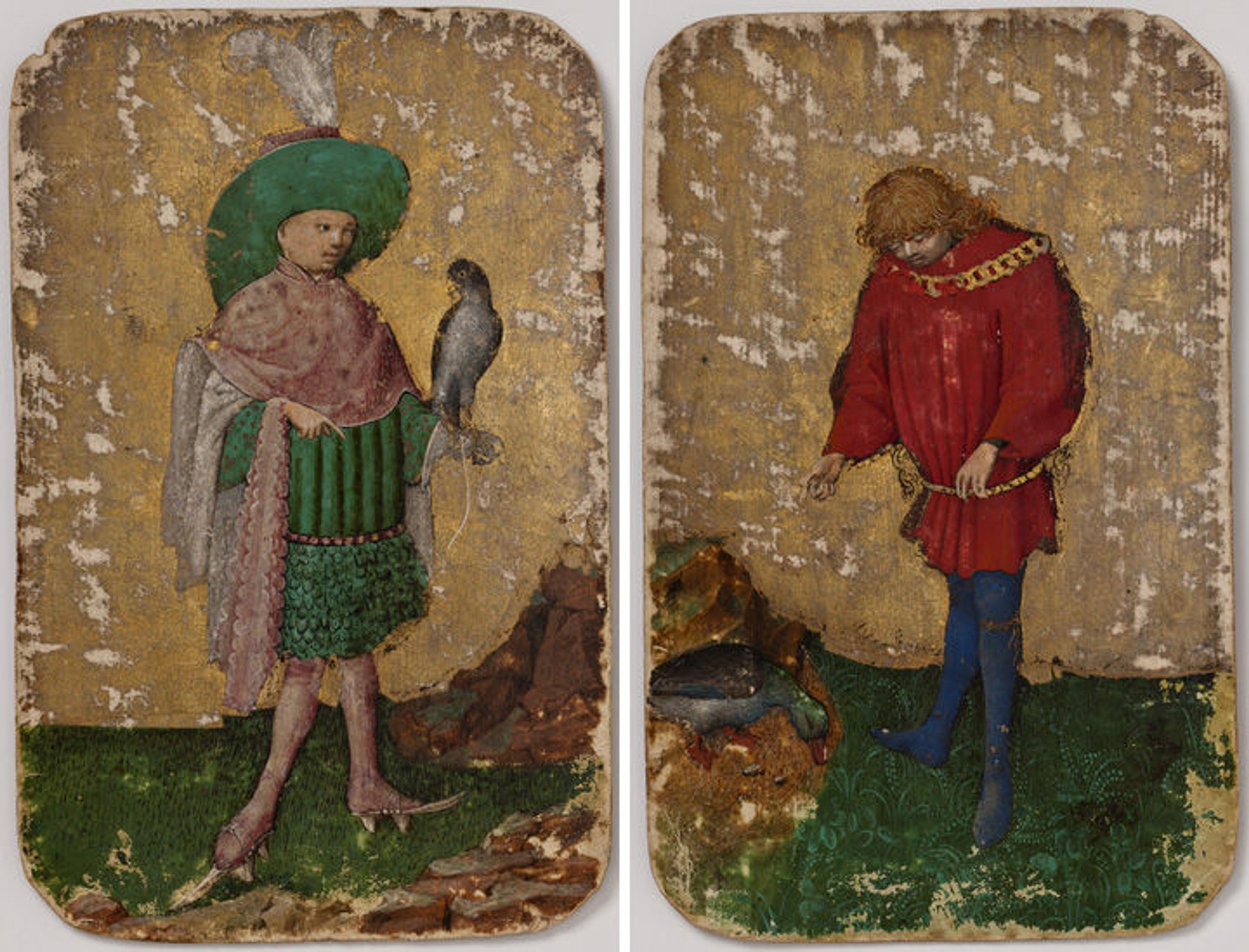
Left: Upper Knave of Falcons, from The Stuttgart Playing Cards. Landesmuseum Württemberg, Stuttgart (KK grau 53). Right: Under Knave of Ducks, from The Stuttgart Playing Cards. Landesmuseum Württemberg, Stuttgart (KK grau 42)
"Hound" is a misnomer for the companion of that suit's queen, as it is a poodle-like lap dog that probably rarely saw the out-of-doors, never mind a hunt. The queens remain comfortably indoors, whereas the rest of the court figures occupy shallow strips of pleasant greenery against a shimmering gold backdrop that provides a glittering shield against the world beyond.

Queen of Hounds, from The Stuttgart Playing Cards. Landesmuseum Württemberg, Stuttgart
In The Stuttgart Playing Cards, the harsh reality of hunter versus hunted yields to a vision of consonance between humankind and the natural world. The youthful, elegant court figures evince the innocence and vitality of a privileged people untroubled by coarse quotidian concerns. Thus, in this deck the hunt serves as metaphor for a world where man and beast cohabit in concord, where the cares of life evaporate—a blissful idyll with little basis in late medieval reality.
Related Link
Tim Husband
Tim Husband is a curator in the Department of Medieval Art and The Cloisters.